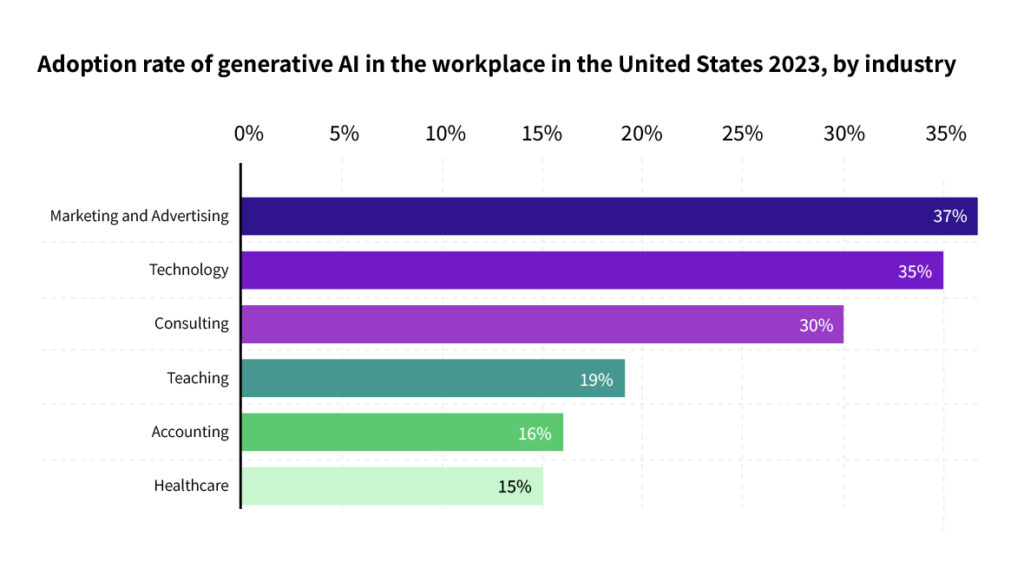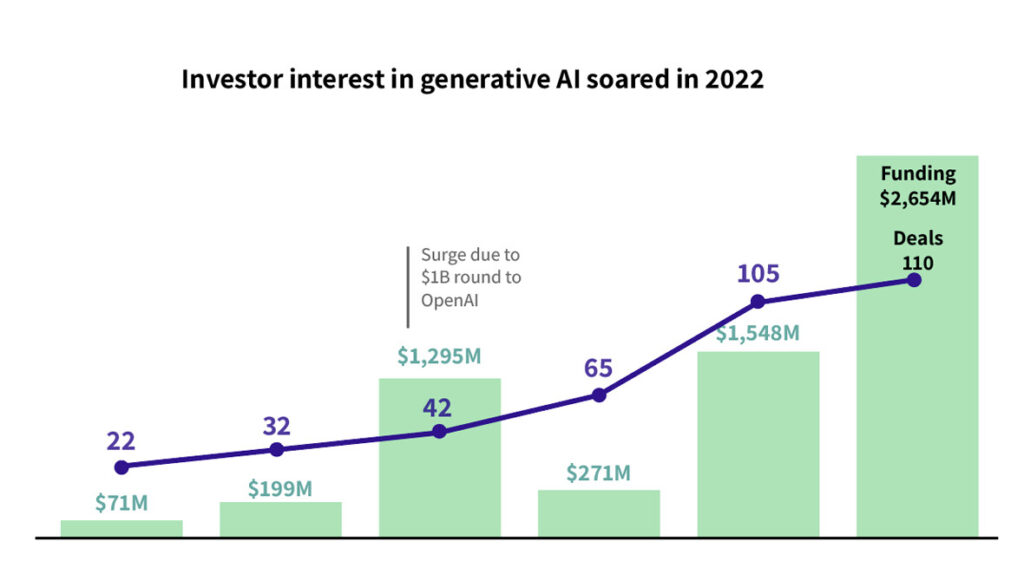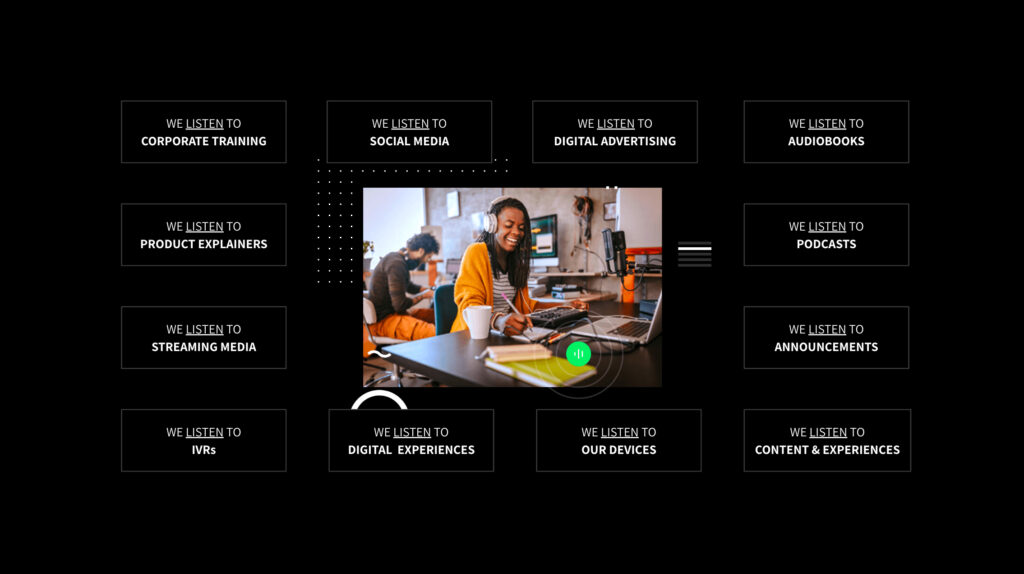Audio by Raine B. using WellSaid Labs
Dive into an extract from our white paper, Make Generative AI Work For You, Using Digital Scalable Voice. Here, we explore the intricate dynamics and potential of generative AI in the business ecosystem.
Interested in the full discussion? Download the white paper here!
Every industry is exposed to generative AI in some way.
Generative AI is a technology that, when given a prompt, creates content with a quality comparable to what a human could reasonably produce. More formally, it is defined as algorithms “that can be used to create new content, including audio, code, images, text, simulations, and videos.”
Researchers continually improve methodologies for collecting data, training models on specific use cases, and making computational optimizations that render the use of these technologies economical. As a result of these innovations, global software infrastructure has reached a maturity that enables developers to extract and analyze information from the internet in vast quantities and with incredible speed.
Understanding generative AI
Generative text stems from Language Models (LMs), which are defined by Assembly AI as “a class of probabilistic models that learn patterns in natural language.” These LMs unlock an entirely new opportunity for companies in every sector to streamline their workflows, obtain customized analysis at scale, and provide detailed and accurate suggestions and responses to their customers.
Bill Gates compared the value of generative AI to that of humans in his GatesNotes article on AI, claiming that, “As computing power gets cheaper, GPT’s ability to express ideas will increasingly be like having a white-collar worker available to help you with various tasks.”
Before we unpack that last statement, let us define generative AI and the various components that make up its infrastructure. We discussed, at a high level, the technical foundation built over the years that now enables the functionality of this technology, but there are 3 critical components we should learn more about before diving deeper: infrastructure, models, and applications.
If we compare the make-up of generative AI to something we are all familiar with—a computer—the infrastructure is like the hardware and storage, the models would be comparable to the operating system, and the applications would resemble the web browser and local apps.
The applications are what we interact with the most in our day to day lives, but they only work if the infrastructure and models are in place to support them. Examples of companies that sell infrastructure are Amazon Web Services, Microsoft Azure, Google Cloud Platform, Nvidia GPUs, Advanced Micro Devices’ graphics cards, among others. The key players building these models include OpenAI, with an $11bn investment from Microsoft. Hugging Face, who announced a strategic partnership with Amazon Web Services this year, and Google, with Google Bard and Google’s recent acquisition of DeepMind.
Industry leaders and shakers
Interestingly, the 3 biggest companies that provide the infrastructure to run these models are also the companies providing, or partnered with, the companies that are developing and monetizing these models. The end user realizes the value of infrastructure and models through the applications. These companies incorporate the infrastructure and models directly into their technology stacks to offer unique data and value to their customers.
Perhaps the most front-of-mind application is OpenAI’s ChatGPT, a conversational AI tool that capitalizes on OpenAI’s most recent language processing model, GPT-4 (Generative Pretrained Transformer 4). ChatGPT essentially ingests a prompt from the user such as “give me an opening sentence to a paper on Theoretical Physics that grabs the attention of college students” and in real time produces an answer that is relevant and often accurate.
This is one of the most talked about applications today. Companies are using ChatGPT to streamline customer service and other external communications as well as automate internal processes like writing emails and code.
Even an article by Sequoia was co-authored by GPT-3 in the fall of 2022. Other applications include Jasper.ai (uses Generative AI to create targeted content in a variety of languages as well as visual art), InVideo (ingests text and delivers video without the need for editing), and OpenAI’s text-to-image tool, DALL-E. Below is a graphic from Enterprise Apps Today that illustrates the adoption rate of Generative AI in the workplace by industry.

Applications for transforming business
Companies can now have creative content, images, video, voice, design recommendations, and more at scale. In an example by TechCrunch, “Coca-Cola inked a deal with OpenAI to use OpenAI’s text-writing ChatGPT and DALL-E 2 to craft ad copy, images and personalized messaging.” In this case, Coca-Cola is scaling their ad creation, with the intention of increasing revenue. Large, multinational corporations aren’t the only ones excited about this new and innovative technology. Investors who are tracking this space are also bullish about the market impact and full potential of the technology. It is still early days for the industry and the use cases we have explored so far are just the tip of the iceberg.

The above graphic from CB Insights depicts an increased interest in Generative AI from venture investors over the past 6 years and as of 2022, a total of $2,654 million in funding with only 110 deals.
With all of the new and exciting possibilities of Generative content comes an opportunity to deliver that information at scale while maintaining brand quality. Synthetic voice, or AI voice, is an artificially created voice that sounds human—when executed well. Examples of synthetic voice applications used by organizations today include voiceover for corporate training content, video production, advertising, business telephony, customer support, interactive and immersive experiences, product integrations, among others. As we are still in Generative AI’s nascence, new and exciting applications will continue to surface.
Voice and brand identity
Organizations can’t have an identity without having a voice.
Every company should have their own voice, from startups to large, multinational organizations. Storytelling has historically laid the foundation for garnering the broader public’s interest. Research from Stanford shows that we are 22X more likely to remember stories than facts alone. Organizations that use this technique in marketing tend to have an increased customer conversion rate over those who use other methods.
Now, with Generative AI and synthetic voiceover, organizations can use their brand identity for customized storytelling at scale that resonates on a personal level with their audience; ultimately earning trust, converting more buyers, and increasing customer retention in the long term.
Conclusion
As we navigate the evolving landscape of generative AI, the possibilities seem infinite. From streamlining workflows to personalized content creation and the advent of synthetic voices, the impact on business strategies and storytelling is undeniable. Now, more than ever, organizations have the tools at their disposal to craft narratives that not only resonate but also convert. As technology continues to push the boundaries of what’s possible, one thing is clear: generative AI is not just the future. It’s the present.


